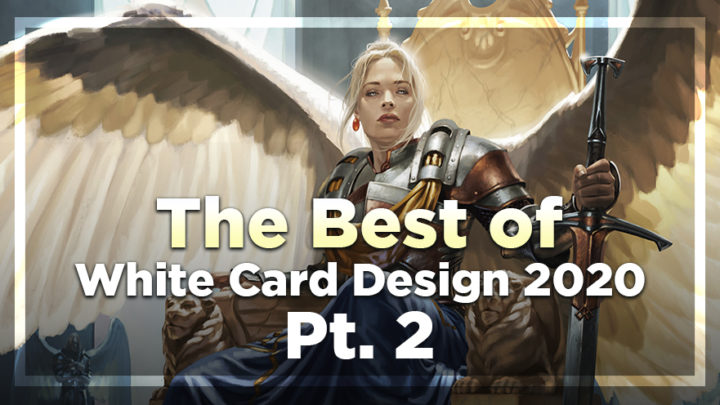As 2020 draws to a close, white’s relevancy continues to be a sticking point for Magic players in most formats. Last year, I put together an evaluation of the year’s cards over at Hipsters of the Coast. The conclusion last year? Well, though white did get some better cards, the rising tide was still threatening to sink white’s ship; for every strong white card, the other colors were still leagues ahead. Is anything different this year? Have we closed the gap? Is white good in Commander?
If you haven’t read Part 1 yet, I encourage you to go back and give it a go. It covers Theros Beyond Death, Ikoria: Lair of Behemoths, Commander 2020 and Core 2021. Once you’re caught up, we’ll get started.
Let’s swing back to Zendikar Rising to begin our Part 2 of the Best of White Card Design in 2020.
Zendikar Rising
Angel of Destiny

Looking back to Part 1, we identified Heliod, Sun-Crowned as a boon to white’s ability to sport alternate win conditions. Well, it looks like we got another piece of that hot, hot action with Angel of Destiny. If the Angel manages to attack a player and meets the prerequisites to trigger, they just straight up lose the game.
This card feels firmly like a Commander card, and seems pretty tough to make work in 20 life formats, where the main win-con of getting an opponent to zero is significantly harder when you’re giving them life and trading one-for-one most of the time.
In Commander, however, I’ve seen firsthand how easy this can be to set up in lifegain decks, and as I said about Heliod, it’s a case of winner-winner, chicken dinner. Giving lifegain decks more payoffs and reasons to gain life is paramount to their being viable strategies in a broader sense.
Archon of Emeria

Archon of Emeria is much more like it when it comes to Constructed. Combining the best of Eidolon of Rhetoric with a sprinkling of Thalia, Heretic Cathar and a pinch of evasion, the Archon is a relevant body that can provide a clock while slowing an opponent right down.
Though it does die to Lightning Bolt, it’s still a great sideboard or even mainboard option in Modern and Legacy, and it’s a card that is doing a lot to make Death and Taxes-style decks relevant again — though not as much as another Zendikar Rising card, which we’ll cover shortly.
It’s nice to see white get a strong hatebear, and even in Commander, this thing can do some serious work, especially at the higher ends of play, where it fits snugly in a Winota, Joiner of Forces list.
Archpriest of Iona

Archpriest of Iona is a card I’m relieved to see. With non-white colors receiving historically powerful one- and two-drops that compete with white’s supposed strength as a color — a strength that’s baked into the game, with white being the aggro weenie color in Constructed formats — it’s been tough to see white struggling to assert its dominance over the low-drop hierarchy.

Though not a huge part of the metagame currently, I can see this card doing a lot of work if the right party creatures are printed in 2021. Don’t forget how good Toolcraft Exemplar was when everything aligned around it.
Felidar Retreat

A punny throwback to Retreat to Emeria, Felidar Retreat asks us, “Is this the power level white needs on its enchantments now?” Well, given the 1/1 Kor has been upgraded to a 2/2 Cat, and the anthem effect has been upgraded to a +1/+1 counter and vigilance for all of our creatures, I’d say yes, please!
It’s probably a little pricey to really do a lot of work in Standard — given it’s currently being squeezed out of Esper Doom Foretold lists — but don’t let that take away from the fact that for once, the white card doesn’t feel too far behind the rest of the pack in pure power level.
Maul of the Skyclaves

In an attempt to create strong equipment that doesn’t homogenize formats, Wizards has moved to creating colored equipment to reduce the free splashability. For the most part, this is a design decision I think is pretty well thought out, and I’m glad it unlocks a card type that has been weak for a long time.
The other new development is equipment that will auto-equip the first time, but cost a little more to re-equip. Again, I think this is an excellent way to make equipment playable but not oppressive, and I’m here for it. Maul of the Skyclaves can provide a big damage swing when it comes down, but can be a little clunkier as the game goes on. It’s good that we have creatures and spells that can mitigate the risk — like Akiri, Fearless Voyager and Sejiri Shelter — but I do find it bemusing how Akroma’s Will flies in the face of colored equipment and asks you to drop arms as you head into battle. Who am I to complain, though — I much prefer powerful cards with restrictions and downsides than haymakers you’d be stupid not to play.
Kabiria Takedown & Sejiri Shelter
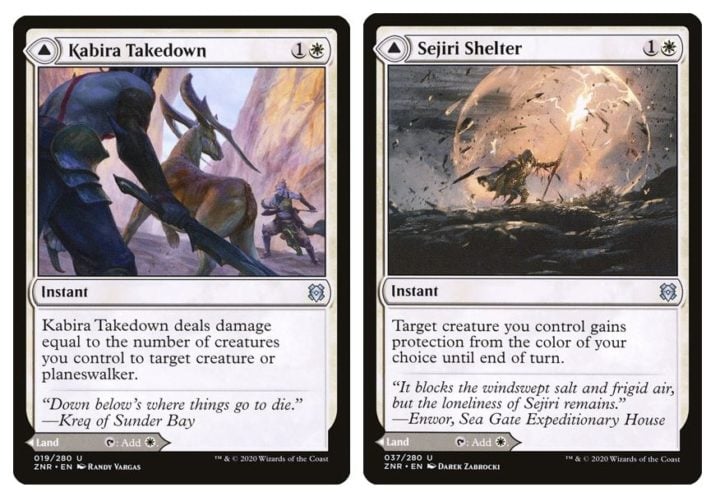
Of the MDFC lands we got in Zendikar Rising, I quite like what white got this time around, and the two I think are the best designed are Kabira Takedown and Sejiri Shelter. White aggro decks tend to struggle with balancing how much removal to run vs how many creatures they require, and they also have issues with flooding. Kabira Takedown answers both of these problems with a flexible card that I hope gives white more consistency, which it desperately needs in Constructed formats where the quantity and quality of modal spells that midrange and control decks have access to is so high.
Sejiri Shelter is another flexible card that provides protection from removal. In a format higher in single-target removal than sweepers, this card becomes more relevant, but where I really like it is in EDH, where justifying the second protection spell is often difficult. When it’s in your mana base? You’ve no reason not to. MDFCs in general are a great card design for Commander, and white in particular is happy to put them in the mana base.
Ondu Inversion is also pretty okay, if that’s what you’re into, but I think Emeria’s Call isn’t quite up to par in Commander. Two 4/4 Angels are good, but not being able to grant the indestructible to your Angels seems a little meager for seven mana, especially compared to the strength of some of the other mythics in the cycle. It’s also notable that the quantity of these lands you can afford to run in a white deck is challenged somewhat by the desire to run a high Plains count for Emeria, the Sky Ruin — and I know which land I’d rather run.
Skyclave Apparition

We can’t end our trip back to Zendikar without talking about one of the most exciting white cards of the year: Skyclave Apparition. It’s been quite some time since we’ve had removal on a body this powerful, and indeed, in white? For three mana? Unheard of.
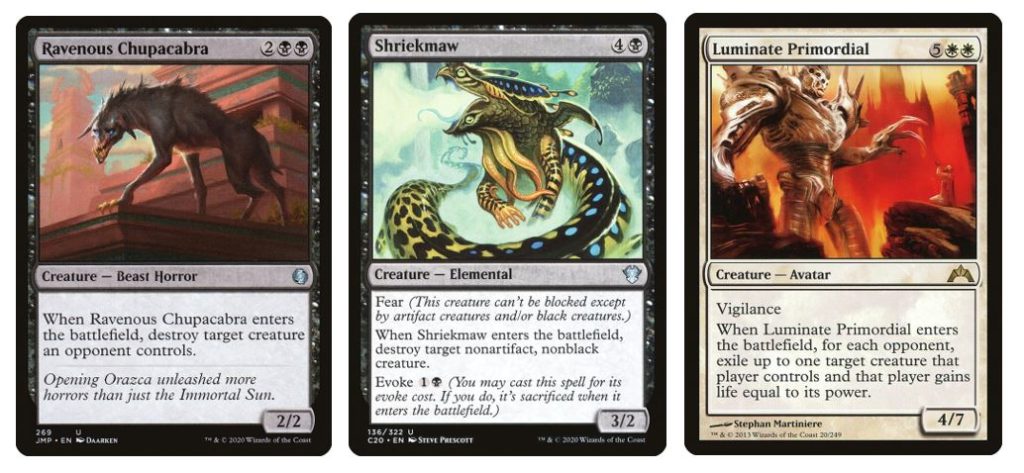
The majority of removal on creatures occurs in black, with white generally getting temporary exile. The “Banishing Light” effect may be balanced for Limited and some Constructed formats, but in many formats, it’s simply not good enough — either because the ways to get around it are too easy or numerous, or because taking a turn off to play an enchantment without playing a creature is too big a tempo loss.
Skyclave Apparition fixes this in two ways. Firstly, the exile effect is attached to a 2/2 body for three mana, which is perfect as far as tempo plays go. Secondly, even if your opponent removes the Apparition, they will never get their original permanent back — they will instead get a token. This is far and away one of the biggest milestones for white this year, and propels the card from good to great. The restriction to CMC four or less is completely reasonable, and is tempered by the fact it can hit any nonland permanent, including Planeswalkers.
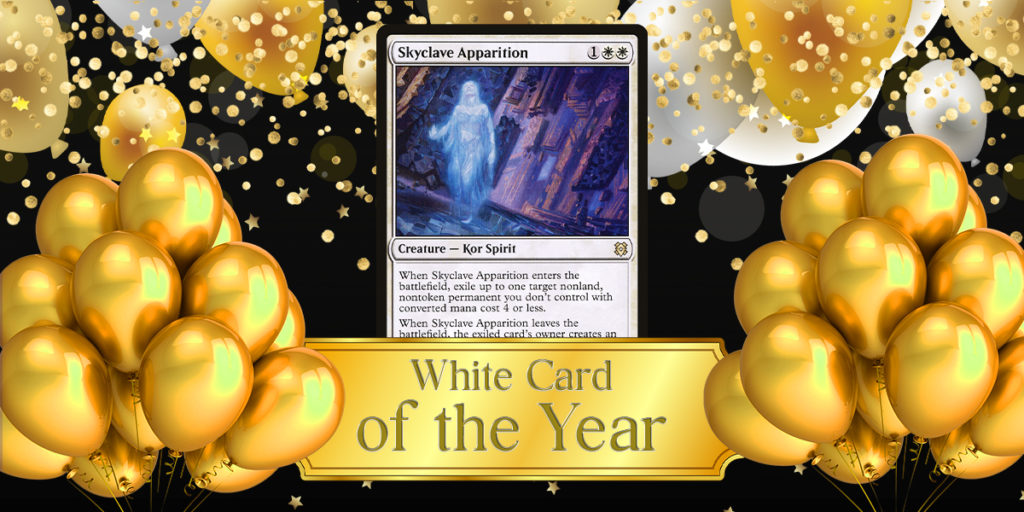
I think if I had to give an award for White Card of the Year, it would undoubtedly go to Skyclave Apparition. It’s dominating Modern and Legacy, has given new life to white creature-based decks, and is easily recurrable in Commander to great effect. It’s also interesting to think how different this card would be if it gave back what it exiled.
Commander Legends
Akroma’s Will

One thing white has been needing is more ways to finish the game with an established board, and Akroma’s Will is a beautiful way of accomplishing that goal. While overrun effects can be difficult to justify running in multiples, we again see modality as an elegant solution to this dilemma. Bundling a team-wide buff together with protection and indestructible is perfect, and I’m really glad this card now exists.

Akroma herself, on the other hand, is a card I think barely misses the mark. At one mana less, I feel like it could have really justified itself, but at seven mana? It’s simply too expensive, especially considering what seven mana gets you in other colors. Oftentimes, it will be easier to just run Odric, Lunarch Marshal and get your anthems elsewhere, as the sharing of keywords is arguably stronger than buffing existing keyword soup creatures.
While you can give her a partner in crime, I don’t think it really assuages the fact you’ll be spending a hefty nine mana the second time you cast her. Commanders simply can’t cost this much anymore without some serious card advantage stapled on.
Armored Skyhunter

Armored Skyhunter, on the other hand, is a great example of card advantage in white. More than just being a one-time trigger when played, Armored Skyhunter instead triggers every time it attacks.
While digging six for an equipment will miss more often than it hits in a deck like Syr Gwyn, Hero of Ashvale, this card truly shines elsewhere — think decks like Akiri, Fearless Voyager that like to run Living Weapons, or extra combat decks.
Hitting a Sword of Feast and Famine off the top and being able to cast an extra combat spell in your second main phase is the stuff dreams are made of, and it’s in these builds that this Cat Knight truly shines.
Ardenn, Intrepid Archaeologist

Much like Armored Skyhunter, Ardenn seeks to improve the lives of those running equipment decks everywhere. What makes this design rock so much in particular is the fact that it doesn’t only apply to equipment; it hits auras, too. So, whether you’re in a Selesnya enchantress deck, or you’re wanting to run all of the Curses, or you’re just running a bunch of arrest effects (like the criminally underrated Prison Term), he can do work in a multitude of scenarios.
What takes equipment decks from taking one or two players out to winning a game isn’t the strength of the cards, but how much mana they can successfully cheat. Up until now, Sigarda’s Aid and Hammer of Nazahn have had to do a lot of heavy lifting. Ardenn is set to add some much-needed redundancy, and it’s refreshing to have access to it. All we need now is another Stoneforge Mystic utility creature, and we’ll be able to enjoy consistency unheard of in voltron decks before.
Benevolent Blessing

It turns out my earlier reservations about Akroma’s Will and colored equipment were shared by Wizards. Benevolent Blessing is an example of a shift in design rippling across the card spectrum. Not making your own auras and equipment fall off is huge, and especially when you consider a format like Pauper — where this card will be legal — bigger still. The introduction of Fall from Favor to a format where Reality Acid can already be put on a creature you might want to enchant with Cartouche of Knowledge means that Benevolent Blessing stands to be a pretty good option to have.
Court of Grace

In a vacuum, Court of Grace is a fantastic card. And in a vacuum, I can safely say that it’s a really great example of white card design. Card advantage with the Monarch, flying Spirits to defend or take the Monarch, and the chance to make 4/4 flying bodies? The card is an absolute house for four mana, and one that fits into numerous strategies and builds.

The thing is, though, it’s in a cycle with Court of Bounty. Court of Bounty is egregiously powerful, especially when so many green creatures now come bundled with reach. I can’t quite fathom how white continues to fall so far behind even when attempting to catch up, and I’ll be damned if I ever settle for that being “on-theme” for white.

No other card in Commander Legends exemplifies this disparity like Seraphic Greatsword. In no world is this card better than Moonsilver Spear, an already virtually unplayable equipment. Sure, it costs two less to play, and trades first strike for a buff; but the trigger to make Angels is now conditional, and is based on a condition you will very rarely meet unless you build around it.
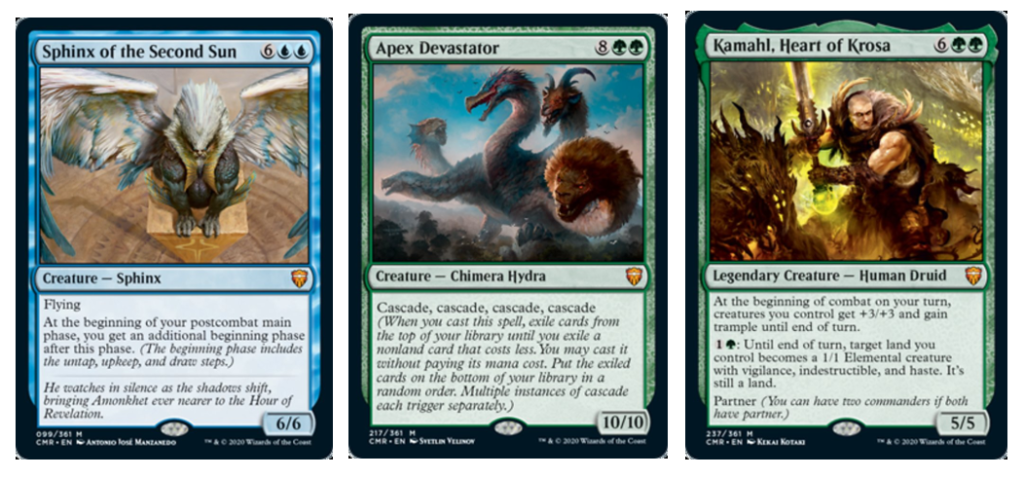
When you compare the quality of white to the other mythics, it’s pretty depressing. Even red, a historically anemic color in Commander, gets access to the likes of Port Razer and Hellkite Courser.
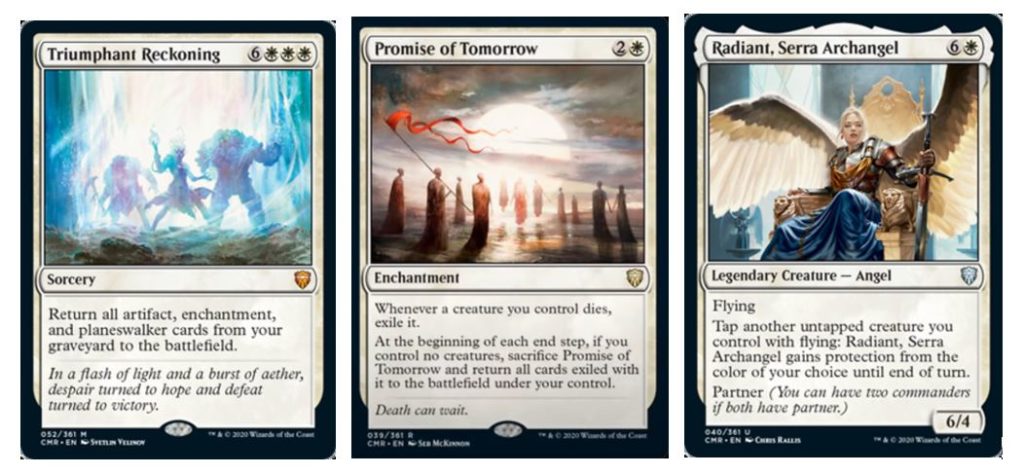
The power level disparity is seen across the set, with Triumphant Reckoning being one of the biggest misses. Rise of the Dark Realms returns all creatures from all graveyards, and for the same amount of mana, Triumphant Reckoning returns none — not even your own. Would it have been so hard to tag creature reanimation on here, and maybe have dropped one or two of the other permanent types?
Similarly, Promise of Tomorrow is on paper a brilliant piece of tech for white when it comes to recursion that ultimately falls short to a disenchant. Putting so many easily exploitable weaknesses on cards like this hurts in the wider context of what other colors — namely green — get away with.
Keeper of the Accord

It’s an interesting point, then, to discuss Keeper of the Accord. We discussed Cartographer’s Hawk and Verge Rangers in Part 1 — can Keeper make up for their shortfalls?
Well, mostly, yes. At four mana, it’s perfectly costed; any cheaper and it wouldn’t trigger as often, as you’d be at parity too soon. I like that it triggers more than once around the table, and with everyone playing a lot of green these days, it’s sure to trigger plenty of times. I think this is close to the endpoint of “catch up,” and like Call the Coppercoats, I believe it’s hard to go more powerful than this without defeating the notion of “catch up” and breaking parity.
Therein lies the question, though: should white just be trying to break parity like the other colors? I believe that ultimately it should, and for that reason, I find it hard to justify some of the newer “catch up” designs in my decks — I’ve built them to be at parity, if not ahead, on mana. A big part of that is hitting land drops, and to do that, you need to run enough lands. Running enough lands means you’ll not miss land drops, though, and that in turn makes Keeper of the Accord trigger less often.
If you like, you can run fewer lands to try and make these cards better, but that’s not for me. I’ll take the sure bet every time, and cash out for fewer (but guaranteed) chips.
Rebbec, Architect of Ascension

Rebbec is closer to the standard of white cards that we should expect. She’s powerful, has numerous applications, and is affordable to cast. Comparing her to Radiant, Serra Archangel, it’s night and day. Rebbec, to me, is firmly of the “new school” of Magic cards, while Radiant is a layover from old design.
Breaking Rebbec takes a combination of a few different cards, but she can do more than enough work on her own. Strong both as a Commander and in the ninety-nine, I expect Rebbec to see a lot of play. Single-target removal is strong these days, and Rebbec does a lot to combat it.
Slash the Ranks

As we round out Commander Legends, Slash the Ranks brings us another option for white board wipes. If we move across slightly from Divine Reckoning, we lose the flashback and creature choice, but gain utility in the ability to remove Planeswalkers and ensure our opponent’s commanders are all that’s left.
I like this for two reasons: firstly, Planeswalkers are getting better and better, and removing them while still allowing some damage from your commander, or your team (pre-wipe) without having to attack a walker is great; second, with Divine Reckoning, most people would let the commander die, as they’re easy to recast. Slash the Ranks improves on both of these factors and places itself as a solid design.
The Takeaway
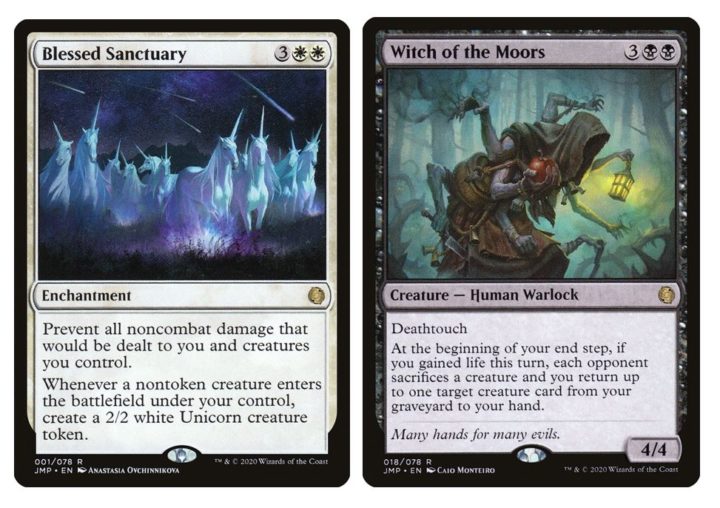
Aside from a few cards in Jumpstart that don’t really merit a mention, there’s not a whole lot of other designs I would like to highlight today. Blessed Sanctuary, for example, is cute, but compared to Witch of the Moors? It’s more of the same, really, and I feel a little awkward about circling back to this point, relevant though it may be.

So, before we go any further, let’s give white its due. It’s true that white has had a significant boost in power level this year. Even looking back at last year, some of the cards have been outclassed already — Akroma’s Will is by and large an upgrade over Unbreakable Formation, for example.
Skyclave Apparition, Court of Grace, Heliod, Sun-Crowned — just a handful of the impressive cards we’ve had the pleasure of playing with this year. They’re all really good, and to complain at this stage would be to discredit these excellent designs.
We need to keep in mind that the great cards we’ve seen this year are just the tip of the iceberg, the start of the proverbial avalanche. For us to see changes in card design based on feedback in the past few years, we really need to wait until 2021 for things to really swing into motion.
The cards we have seen, though — like Mangara, the Diplomat — bode well for the future. Overall, it’s been a great year, and for once, the hits are starting to look like they might outnumber the misses. The issue isn’t that things aren’t moving in the right direction; it’s just how fast we’re headed there, and whether we have the same power engine as the other colors.
Last year, I noted that for every solid card white got, colors like green got better ones. This year, the goalposts have moved slightly: we’re now at the point that for every great white card, colors like green get better ones. Bringing white up to speed is only half the battle — we need to take the foot off the gas when it comes to the other colors.

There’s no better way to frame that than with the two new non-white hatebears. The majority of discourse around these cards would simply not have happened had they been a little less pushed, and all it would have taken would have been to either increase their mana cost or make their effects trigger once instead of being static. If white is ever going to catch up, then we either need to start putting drawbacks on cards again, or stop giving white so many hoops to jump through.
2020, for all of its turmoil, was at least a better year for card design when it comes to the white part of the color pie. I’ve concentrated on mono-white today, but there are dozens more examples of multicolor cards that have benefitted from white’s improved design. I look forward to 2021, quietly confident, but knowing that it’s make or break time. This is the year where we see if the feedback was taken on board. Onwards, to Kaldheim!

Kristen is Card Kingdom’s Head Writer and a member of the Commander Format Panel. Formerly a competitive Pokémon TCG grinder, she has been playing Magic since Shadows Over Innistrad, which in her opinion, was a great set to start with. When she’s not taking names with Equipment and Aggro strategies in Commander, she loves to play any form of Limited.

